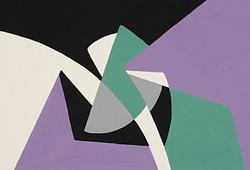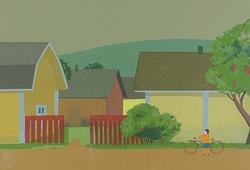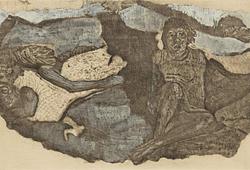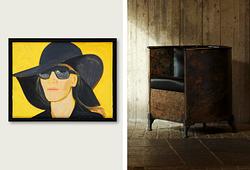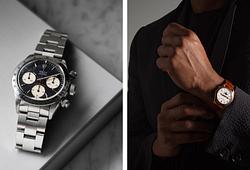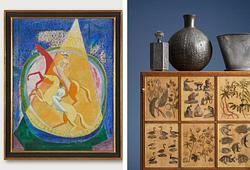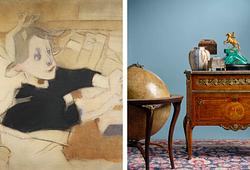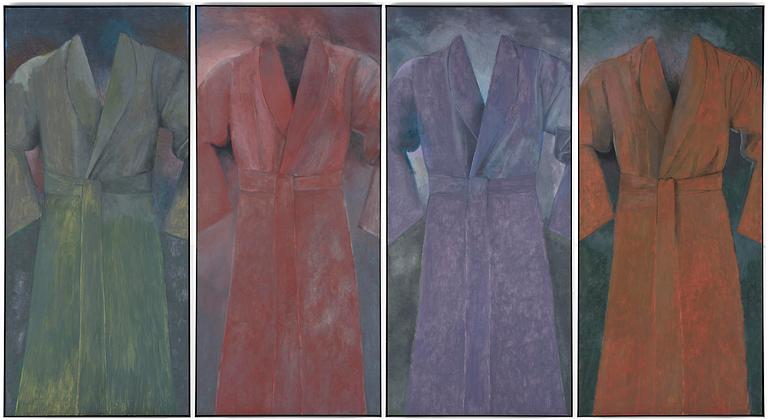Jim Dine
"Four Robes Existing in this Vale of Tears"
Signed Jim Dine and dated 1976 on number 4 verso. Polyptych, panel, each 203 x 91.5 cm. Total dimensions 203 x 366 cm.
Alkuperä - Provenienssi
Collection of Mr. and Mrs. Gene R. Summers, Laguna Beach, California.
Kirjallisuus
David Shapiro, "Jim Dine", 1981, listed as no. 162, illustrated p. 61-62.
Feinberg 51.
Muut tiedot
Polyptyken "Four Robes Existing in this Vale of Tears" behandlar ett av Jim Dines mest ikoniska motiv, badrocken. Badrockar har varit ett centralt motiv genom hela hans konstnärskap och återkommer i flera av hans många tekniker. Dine började måla badrockar redan på 1960-talet. Trots att han själv hävdar att han aldrig använt badrock personligen antog de tidigt formen av självporträtt. I en intervju i ARTnews september 1977 beskrev Dine sitt förhållande till den magiska badrocken: “The robes have become much more mysterious than they used to be, and that’s because I understand them more. Obviously, there’s some hidden significance there. But what’s funny is that I don’t own a bathrobe. I don’t wear one. I don’t walk around in one. I never see bathrobes around me, nor do I see people wearing them. I don’t have a bathrobe to paint from. What I use is what I’ve used from the very beginning - a newspaper ad which I clipped out of The New York Times back in 1963. The ad shows a robe with the man airbrushed out of it. Well, it somehow looked like me, and I thought I’d make that a symbol for me. Actually, it all began when I wanted to paint a self-portrait . . . and just couldn’t. It’s important for me to say this, because what I really wanted to do was sit in front of a mirror and paint a portrait of myself. But at the time, I was in analysis and the pressures I felt prevented me from going through with it.”
David Shapiro skriver om det aktuella verket: "In 1976, Dine painted one of his most compelling "serial" images, Four Robes Existing in this Vale of Tears (plate 162). For those who have compared the robes of this period to Rothko, one might say that Dine accepts this as a compliment, but his art does not depend any longer on the luminous predecessor, Here, Dine has created a completely mature version of figuration without the figure. The green robe, the red, the lavender, and the orange stand in quiet dignity to amaze us. It is for this reason, perhaps, that Dine in his title uses the almost passive "existing," but not so much to emphasize passivity as to give us a sense of ontological calm.
Indeed, these robes are presentations of four color symphonies in a Whistlerian mood of fog and interior atmospherics. They are persistent in the way a Morandi seems to be patient with his domestic constructions. Dine has recently created a robe with a green balcony out of Manet, but usually the robes are not so spatially fixed. They are figures of isolation without the neurosis that Antonioni loved in his color symphonies with the isolated heroine, say, in his film "The Red Desert." But there is no embarrassment at the theme of loneliness, just as once Dine was unembarrassed with the heroics of happiness and pleinairism. The robes have all the abstract cruciformality that Joseph Masheck has analyzed as a fundamental compositional device in much geometric painting. In Cardinal of the same year, an even more painterly version is made in a red as worldly and lavish as any prelate in Raphael”.
Jim Dine har representerats av Pace Gallery New York sedan 1976 och det var också där som han för första gången ställde ut en serie stora målningar med badrocksmotiv. Polyptyken "Four Robes Existing in this Vale of Tears" är utförd 1976, en viktig period för konstnären. 1978 hade han en retrospektiv separatutställning på The Museum of Modern Art (MoMA) i New York. Fler utställningar skulle följa och till dags dato har han ställt ut mer än 300 gånger på institutioner och gallerier runtom i världen.






